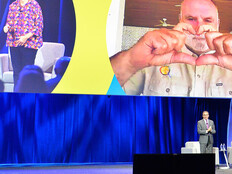One key measurement of success: patient satisfaction surveys, which have helped us identify and deliver important service enhancements in an effort to grow volume and expand services.
To that end, patients can leverage the same MyChart video visit platform for a postoperative video visit with their orthopedic surgeon, a therapy video visit with their mental health specialist or a check-in with their dietary provider, all from the comfort of their home.
We have launched more than 25 MyChart video visit initiatives in specialties that include bariatrics, oncology, cardiology, endocrinology, gynecology and gastroenterology. More specialties are set to follow.
Care from All Angles
For patients who visit an NYU Langone emergency department, we have deployed a standard suite of telemedicine carts that can be leveraged by remote specialists for services such as neurology and psychiatry, enabling them to provide emergent treatment from their smartphone or tablet using our video visit infrastructure.
For patients admitted to the hospital, we’ve deployed in-room tablets through our MyWall platform for providers to initiate on-the-fly telemedicine encounters with any patient in one of our 350-plus inpatient rooms at the Kimmel Pavilion and other facilities.
A surgeon, for example, can quickly check in with a patient over video, hours after their surgery, which improves patient satisfaction and reduces time to discharge.
With remote patient monitoring, providers can continuously track a patient’s critical health data measurements to proactively manage their care. During an office visit, providers can access the electronic health record and recommend monitoring for a clinical value such as heart rate, blood pressure, step count or lung spirometry.
Patients can easily opt in to sharing their data using the NYU Langone Health app, at which point the clinical values will automatically flow from a patient’s device directly into their electronic health record so doctors can review trends and guide treatment.
MORE FROM HEALTHTECH: Find out how telehealth is taking modern healthcare to the next level.
Patient Satisfaction Is Gauged to Improve Offerings
As we developed our program, we recognized that real-time technical support was critical to ensuring a high-quality experience that our users could trust.
It’s why we created the telemedicine support desk, which is available 7 days a week to ensure that patients and providers are able to successfully connect to their virtual encounter. As a result, we have a 97 percent successful connection rate, which ranks No. 1 across all of Epic’s customers who leverage their telehealth product.
We measure patient satisfaction by text messaging patients after a video visit. Overall, their satisfaction averages 4.64 out of 5 stars; ease of use of the technology rates at 4.60 out of 5 stars.
At NYU Langone Health, virtual health is not defined by a handful of individual projects, but rather an ecosystem that works harmoniously to offer integrated telemedicine services to both patients and providers in a variety of care settings.
We’re excited to grow our virtual health capacity and offer patients and providers even more options.










